Approximating functions on R
Contents
Approximating functions on \(R\)¶
Randall Romero Aguilar, PhD
This demo is based on the original Matlab demo accompanying the Computational Economics and Finance 2001 textbook by Mario Miranda and Paul Fackler.
Original (Matlab) CompEcon file: demapp01.m
Running this file requires the Python version of CompEcon. This can be installed with pip by running
!pip install compecon --upgrade
Last updated: 2022-Oct-22
About¶
This demo illustrates how to use CompEcon Toolbox routines to construct and operate with an approximant for a function defined on an interval of the real line.
In particular, we construct an approximant for \(f(x)=\exp(-x)\) on the interval \([-1,1]\). The function used in this illustration posseses a closed-form, which will allow us to measure approximation error precisely. Of course, in practical applications, the function to be approximated will not possess a known closed-form.
In order to carry out the exercise, one must first code the function to be approximated at arbitrary points. Let’s begin:
Initial tasks¶
import numpy as np
import pandas as pd
import matplotlib.pyplot as plt
from compecon import BasisChebyshev, BasisSpline
Defining the functions¶
Function to be approximated and derivatives
def f(x): return np.exp(-x)
def d1(x): return -np.exp(-x)
def d2(x): return np.exp(-x)
Set degree and domain of interpolation
n, a, b = 10, -1, 1
Chebyshev interpolation¶
In this case, let us use an order 10 Chebychev approximation scheme:
F = BasisChebyshev(n, a, b, f=f)
One may now evaluate the approximant at any point x calling the basis:
x = 0
F(x)
1.0000000005485141
… one may also evaluate the approximant’s first and second derivatives at x:
print(f'1st derivative = {F(x, 1):.4f}, 2nd derivative = {F(x, 2):.4f}')
1st derivative = -1.0000, 2nd derivative = 1.0000
… and one may even evaluate the approximant’s definite integral between the left endpoint a and x:
F(x, -1)
1.7182818284646348
Compare analytic and numerical computations¶
pd.set_option('display.precision', 8)
pd.DataFrame({
'Numerical': [F(x), F(x, 1), F(x,2), F(x, -1)],
'Analytic': [f(x), d1(x), d2(x), np.exp(1)-1]},
index = ['Function', 'First Derivative', 'Second Derivative', 'Definite Integral']
)
| Numerical | Analytic | |
|---|---|---|
| Function | 1.00000000 | 1.00000000 |
| First Derivative | -1.00000000 | -1.00000000 |
| Second Derivative | 0.99999995 | 1.00000000 |
| Definite Integral | 1.71828183 | 1.71828183 |
Plots of approximation errors¶
One may evaluate the accuracy of the Chebychev polynomial approximant by computing the approximation error on a highly refined grid of points:
nplot = 501 # number of grid nodes
xgrid = np.linspace(a, b, nplot) # generate refined grid for plotting
figures=[] # to save all figures
def approx_error(true_func, appr_func, d=0, title=''):
fig, ax = plt.subplots()
ax.hlines(0,a,b, 'k', linestyle='--',linewidth=2)
ax.plot(xgrid, appr_func(xgrid, d) - true_func(xgrid))
ax.ticklabel_format(style='sci', axis='y', scilimits=(0,0))
ax.set(title=title, xlabel='x', ylabel='Error')
figures.append(plt.gcf())
Plot function approximation error¶
approx_error(f,F,title='Chebychev Approximation Error - Function')
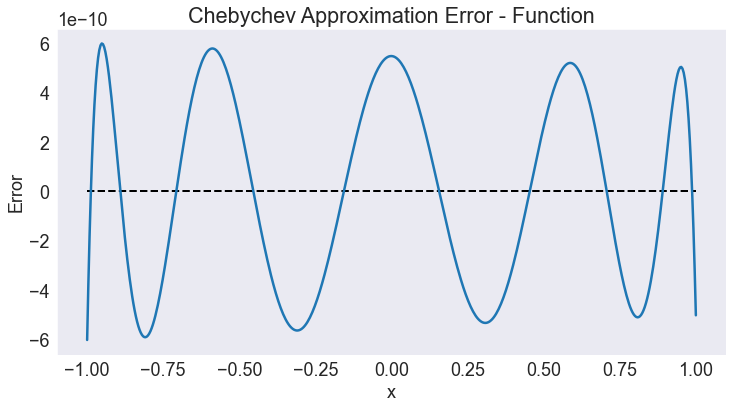
The plot indicates that an order 10 Chebychev approximation scheme, produces approximation errors no bigger in magnitude than \(6\times10^{-10}\). The approximation error exhibits the “Chebychev equioscillation property”, oscilating relatively uniformly throughout the approximation domain.
This commonly occurs when function being approximated is very smooth, as is the case here but should not be expected when the function is not smooth. Further notice how the approximation error is exactly 0 at the approximation nodes — which is true by contruction.
Plot first derivative approximation error¶
approx_error(d1,F,1, title='Chebychev Approximation Error - First Derivative')
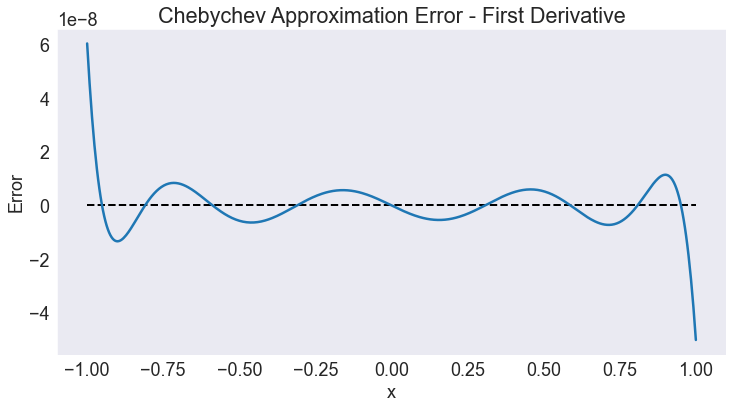
Plot second derivative approximation error¶
approx_error(d2,F,2, title='Chebychev Approximation Error - Second Derivative')
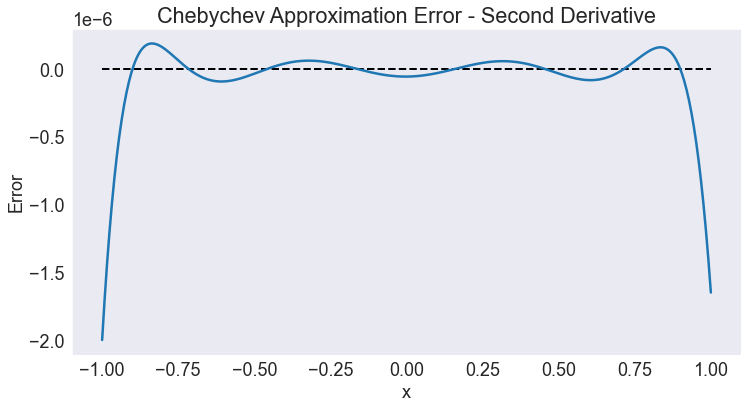
Cubic spline interpolation¶
Let us repeat the approximation exercise, this time constructing a 21-function cubic spline approximant:
n = 21 # order of approximation
S = BasisSpline(n, a, b, f=f) # define basis
yapp = S(xgrid) # approximant values at grid nodes
Plot function approximation error¶
approx_error(f,S,title='Cubic Spline Approximation Error - Function')
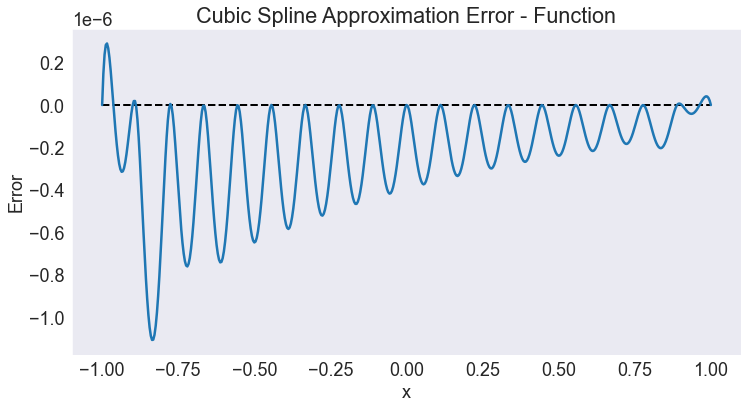
The plot indicates that an order 21 cubic spline approximation scheme produces approximation errors no bigger in magnitude than \(1.2\times10^{-6}\), about four orders of magnitude worse than with Chebychev polynomials.
Plot first derivative approximation error¶
approx_error(d1,S,1, title='Cubic Spline Approximation Error - First Derivative')
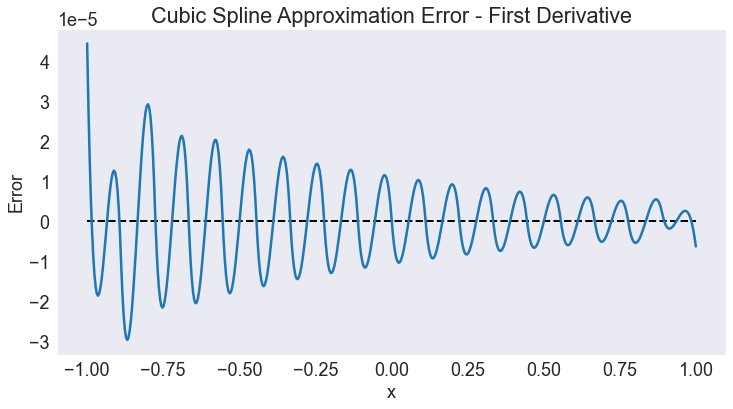
Plot second derivative approximation error¶
approx_error(d2,S,2, title='Cubic Spline Approximation Error - Second Derivative')
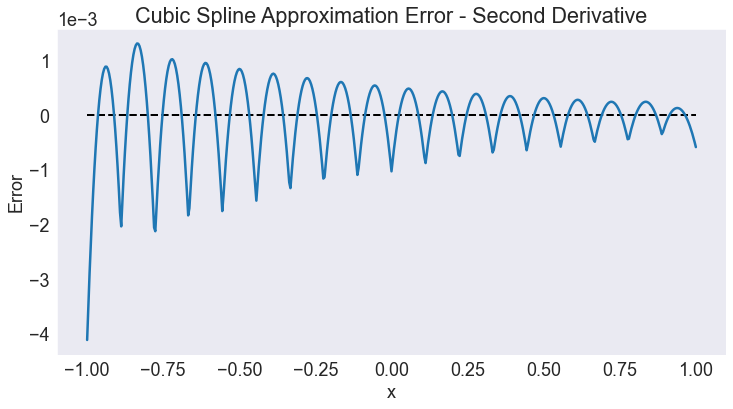
Linear spline interpolation¶
Let us repeat the approximation exercise, this time constructing a 31-function linear spline approximant:
n = 31
L = BasisSpline(n, a, b, k=1, f=f)
Plot function approximation error¶
approx_error(f,L,title='Linear Spline Approximation Error - Function')
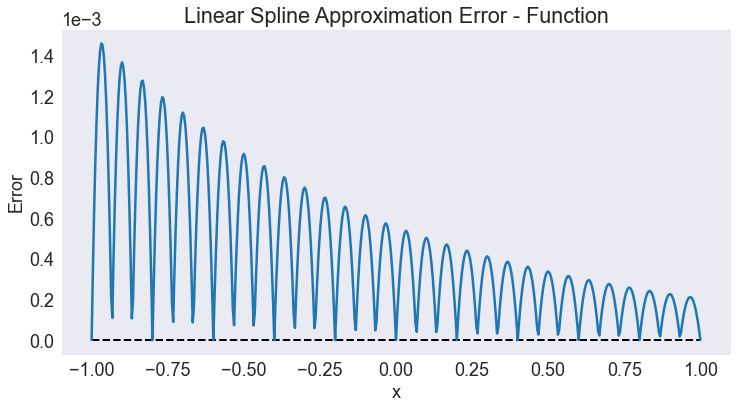
The plot indicates that an order 21 cubic spline approximation scheme produces approximation errors no bigger in magnitude than \(1.2\times10^{-6}\), about four orders of magnitude worse than with Chebychev polynomials.
